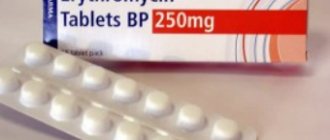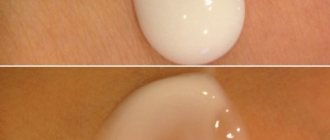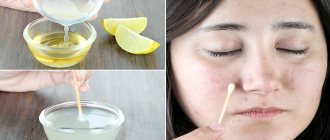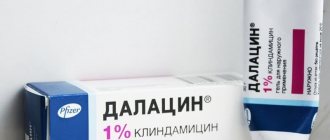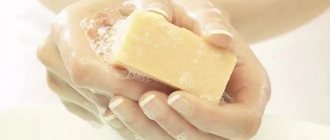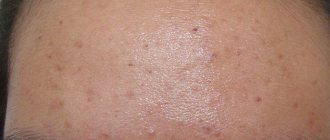Our article today is devoted to such a common problem as pimples, blackheads, comedones and increased oily skin - the site “Beautiful and Successful” will give a lot of useful tips on how to avoid all this.
And we’ll talk more specifically about how to use dimexide for acne on the face. This drug has been successfully used in the cosmetology industry for quite a long time, and it turns out that it can be used to make affordable home procedures.
What is Dimexide used for?
The drug is prescribed for problems with the functioning of the musculoskeletal system. In addition, in case of subcutaneous damage to soft tissues, Dimexide actively relieves the inflammatory process. The ability of the drug to enhance the effect of other drugs is often used by doctors in antibacterial therapy. Direct indications for prescribing Dimexide are:
- bursitis;
- arthrosis;
- arthritis;
- radiculitis;
- gout;
- osteochondrosis;
- pain syndrome due to intervertebral hernia;
- scleroderma;
- skin ulcers;
- swelling accompanied by pain;
- synovitis
In addition to the above problems, Dimexide is also used in other areas, including cosmetology.
Dimexide: properties of the drug
The main active ingredient of this pharmaceutical product is dimethyl sulfoxide. It is an antiseptic (relieves inflammation, kills germs) and analgesic (relieves pain), therefore it is often prescribed after operations and surgical interventions, to treat inflammatory processes of the skin and mucous membrane.
But the most important “trick” of dimethyl sulfoxide is the following property: it is able to penetrate into the deep layers of the skin so quickly that after just a few minutes the molecules of this substance can be detected in the blood. In this case, dimexide actually overcomes the cell barrier and is able to deliver various nutrients or drugs (for example, antibiotics, anti-inflammatory or vitamin preparations) there.
That is why the most common way to use dimexide solution for acne or other skin problems is to mix it with other drugs for which it acts as a “conductor,” delivering them unchanged into the dermis. In cosmetology, dimexide is also included in many creams and ointments so that nutrients penetrate the skin faster and more efficiently.
This drug can be called universal - the women's site sympaty.net has already talked about how to use dimexide for cellulite and for hair growth.
How to dilute Dimexide for hair
As a result of the fact that Dimexide was seen as a kind of catalyst for some local drugs, which quickly penetrated the cellular barrier deep into the tissues, Dimexide began to be used as part of cosmetic masks.
In particular, by mixing a teaspoon of the substance concentrate with essential oils, lemon juice, aloe extract and honey, you get an effective hair mask. Its regular use relieves hair from brittleness, gives rich shine and restores natural growth. And if you mix a teaspoon of Dimexide with ground red pepper and apply it to the scalp, holding for 15 minutes, you can wake up dormant bulbs, resulting in thicker curls.
Composition and release form
The main and only active ingredient of the drug Dimexide is a chemical compound called Dimethyl sulfoxide, the effectiveness of which has been proven over decades of medical practice.
It is produced in two formats:
- Solution;
- Gel.
Both the first and the second remedy have a high potential for accelerating the absorption of the target active substance and, although weak, have an analgesic and anti-inflammatory effect.
How to dilute Dimexide for boils
Inflammation of the skin glands, which develop into boils, is often accompanied by a local increase in temperature and tension on the skin surface. In order to relieve pain and reduce tissue tension due to growing inflammation, dilute Dimexide in warm water in the proportion of 1 ml of concentrate per 10 ml of clean water. Cotton pads are soaked in the resulting solution and applied to the boils. It is important not to rub, rub, or knead an unruptured boil. Safe use is considered to be simply applying a moistened swab to the inflamed area.
When is dimexide used?
I would like to note that in no case should pure dimethyl sulfoxide be mixed only with oils, since it does not dissolve in them and, due to deposition on the surface of the skin, it causes severe chemical burns. Also, if you doubt that you can correctly calculate its use and are afraid that your skin may react with irritation or dermatitis, it is better to consult a dermatologist.
How to dilute Dimexide for heel spurs
The situation with inflammation of the heel, called a heel spur, can be resolved not only through surgery. In some situations, a conservative method using Dimexide may help. It is important to begin treatment at the first signs of inflammation in order to prevent the disease from entering an irreversible phase when the help of a surgeon is required. For spurs, use a concentration of Dimexide diluted in water in a one to one ratio. Taking 20 ml of the drug you need to add 20 ml of water.
For severe pain, novocaine 2% is added to the solution in a volume equal to the amount of Dimexide and water. A cloth is moistened in the resulting liquid and placed on the sore spot. The compress is covered with polyethylene and a wool sock is put on.
Side effects
Possible burning, redness, chemical burns, rashes and itching.
With significant doses and indoor use, dizziness and nausea may occur when inhaling the odor of dimethyl sulfoxide. Other side effects caused by individual intolerance to the components of the drug.
Full review and detailed information about side effects
Side effects >>>
Dimexide for sinusitis
Sinusitis is an inflammation of the maxillary sinuses, accompanied by an accumulation of mucus pressing on the nasal cartilage from the inside. The disease may be accompanied by redness of the skin over the sinuses, as well as an increase in temperature, which is localized in the area of the inflammatory process. Dimexide will help relieve swelling of the mucous membranes and reduce inflammation in the nasal passages. It is mixed with saline solution in a ratio of 1:3.
You can also add aloe juice or vasoconstrictor nasal drops, for example, naphthyzine or phenylephrine. After moistening cotton swabs in the resulting solution, they are inserted into each nasal passage and kept in this position for up to 20 minutes. This treatment can be repeated for up to 7 days in a row.
Methods of application
To increase the effectiveness, dimethyl sulfoxide can be added to a variety of masks and talkers, which will increase their effectiveness and speed up the achievement of the desired effect.
Masks
Adding this product to the composition will help enhance their effectiveness and please the owner of problem skin with excellent results in a short time. Below we have collected the recipes for the best face masks with dimexide.
With erythromycin
This combination, which contains an antibiotic, is perfect for both oily and combination skin types and the treatment of extensive acne and severe inflammation.
To prepare you will need to take:
- Dimethyl sulfoxide - one teaspoon;
- Boiled water - five tablespoons;
- Erythromycin - three tablets.
Grind and mix the antibiotic with dimethyl sulfoxide and boiled water. Use this remedy once a day before bed, the effect will be noticeable within a week.
With clay and streptocide
A mask made of clay and streptocide with dimexide is well suited for skin on which a large number of various acne lesions are localized.
To prepare it you will need to take:
- Dimexide – 5 drops;
- Streptocide – ½ teaspoon;
- Blue or green clay - 3 tablespoons;
- Warm water – 5 tablespoons.
It is good to move all components among themselves and apply to problem areas of the skin. You need to keep it for no more than 20 minutes, after a while, rinse with warm water.
With solcoseryl
This type of mask is perfect for combating post-acne and acne spots, since solcoseryl has an excellent regenerating effect, and the dimescid in the composition will only enhance its effectiveness.
To prepare you will need:
- Dimexide – one teaspoon;
- Boiled water - five tablespoons;
- Solcoseryl (the amount depends on the surface area to which the product will be applied).
Adverse reactions
The use of Dimexide, like any other drug, can lead to unpleasant side reactions. Among them:
- redness of skin areas;
- burning in the area of application;
- allergic reactions, manifested by nasal congestion, drainage from the eyes, bronchospasm and rhinitis;
- skin pigmentation;
- nausea;
- muscle weakness;
- dizziness;
At the first signs of illness as a result of using Dimexide, you should definitely stop therapy and discuss what happened with your doctor.
How does Dimexide work?
As mentioned above, the main active ingredient of the drug is dimethyl sulfoxide. Its main positive quality is the high rate of penetration into the epidermis and, concomitantly, the acceleration of penetration into the deep layers of the skin of a number of different medications.
After penetration, the active substance has a local analgesic, antiseptic and anti-inflammatory effect.
If dimethyl sulfoxide is the main active ingredient, then its effectiveness in this case will be extremely low. To enhance the effect, it is necessary to add an antibacterial component to the combination, for example:
- Erythromycin;
- Doxycycline;
- Clarithromycin;
- Metronidazole.
Or some kind of alcohol, for example boric or salicylic.
Frequently asked questions about the use of Dimexide for acne
Can dimexide be used for acne during pregnancy?
Doctors and manufacturers of drugs based on dimethyl sulfoxide do not recommend use during pregnancy and breastfeeding. Clinical trials have not been conducted in this group and therefore the consequences of use are unpredictable.
Can dimexide be used to treat acne with glaucoma?
The instructions for use describe all contraindications; it cannot be used if you have glaucoma. Also in the list of contraindications are diseases such as cataracts, pronounced atherosclerosis, cardiovascular failure, kidney and liver diseases, after any type of stroke and angina.
I use dimexide after a stroke, but it is on the list of contraindications, is it dangerous?
It is dangerous, it was prescribed in the contraindications section: after a stroke, taking the drug is contraindicated. You assume all risks and complications resulting from the use of drugs with dimethyl sulfoxide after a stroke.
Is it possible to use dimexide for childhood acne?
Contraindications for children are specified in the instructions for use of the drug: use is contraindicated for children under 12 years of age. Some medications and ointments containing dimethyl sulfoxide should not be taken by children under 16 years of age. Read the instructions and the contraindications section very carefully before using it on children.
Doctors recommend
- After applying Dimexide to the skin, do not wrap it with bandages, films or other materials that interfere with air access. If it is necessary to apply a compress, be sure to use a soft cloth or cotton swab, do not use film and do not hold the compress for more than 15 minutes
- use the minimum effective dosage
- in case of allergic reactions, immediate cancellation is recommended
- allows the possibility of driving a vehicle during treatment.
Dimethyl sulfoxide can enhance not only the activity, but also the toxicity of drugs. Caution should be exercised when prescribing it and using it simultaneously with other medications.
Symptoms and causes of acne
The causes of the disease remain unclear. In the mechanism of development and appearance of acne, the main role is played by seborrhea, which reduces the bactericidal effect of sebum and leads to the activation of coccal flora. An important role in the mechanism of acne is played by the bacterium Propionibacterium acnes and its metabolic products.
Common acne (juvenile pimples, acne) develops in boys and girls during puberty and gradually disappears by the age of 25-30. The appearance and worsening of acne is also influenced by menstruation, stress, heat, high humidity and genetic factors. It is known that cosmetics containing lanolin and paraffin are also the cause of acne. Acne can also be a side effect of certain medications.
Hyperkeratinization and plaque formation of keratin and sebum leads to enlargement of the sebaceous glands, especially during skin maturation during puberty. An increase in sebum production occurs during adrenarche, when the production of dehydroepiandrosterone increases.
The accumulation of sebum can lead to infection. The immune system destroys the bacteria, and the pus is “packed” into clusters under the epidermis. Patients try to get rid of pustules by removing them themselves and in non-sterile conditions. Such damage to the underlying layers disrupts the delicate structure of the dermis and creates a weakened zone that is attacked by bacteria. As a result, the immune system causes acne to spread.
